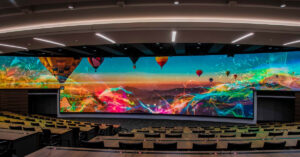
Business / Design / Education / Healthcare
The Future of AV Control: Virtual Processors Made Simple
Published April 10, 2023
Dedicated hardware processors have been the go-to solution for controlling AV systems, but they’re hard to come by these days. Back orders of processors and other critical components can hold up projects due to the ongoing chip shortage. It’s a broken record at this point but we’re getting creative to overcome the challenge.
Manufacturers now offer virtual control processors as flexible alternative, but buyer beware, they can have their pros and cons compared to traditional dedicated hardware.
So, how do virtual control processors work? Essentially, they are software-based solutions that run on an owner’s server or virtual machine. They communicate with AV devices over the network, just like a hardware processor would. The main difference? The software uses the processing power of the owner’s existing server paired with a flexible license key. This route makes the solution more scalable and cost-effective.
To give you a better idea of the differences between hardware and virtual control processors, check out this graphic:

Frequently Asked Questions About Virtual Processors
We’ve had a variety of clients interested in virtual processors due to the availability. Here are some of the most common questions we’ve heard so far about virtual control processors.
Does the processor connect to the Internet?
Yes. Some manufacturers like QSC, Extron, or Crestron require an Internet connection for the server to regularly verify the license key. Others, like Kramer, only require an Internet connection once to verify the key.
IT is not happy about that. Is there any way to avoid an internet connection?
Yes. Manufacturers are coming out with license dongles. The dongle contains the license key and plug directly into the dedicated server. If the dongle is lost or stolen, the machine will not work and cannot be replaced.
Does the processor have to be on our main network?
No, it can be on a segregated network, as long as it has access to the Internet. Ideally, all the AV components would be on their own VLAN to reduce cross traffic with other data.
If the processor is virtual, how do you control equipment requiring physical IO?
A majority of system components can be ethernet connected. However, there are special use cases with equipment requiring RS-232, relay, IR, and other hardline connections. A variety of adapters which convert to ethernet are available to help us get your hardware communicating with the processor.
In conclusion, virtual control processors offer a flexible, cost-effective way to control AV systems. Organizations can now move forward with projects or manage room control on a larger scale.
Interested in how virtual control processers could help your organization? Send us a message for a FREE consultation with one of our audiovisual experts.
Get Expert AV Assistance
Latest Blogs
About Arrow AV Group
We are a premiere audiovisual integration firm serving corporate, government, healthcare, house of worship, and education markets with easy-to-use solutions that drive success. Family-owned and operated from Appleton, WI for over 35 years.





